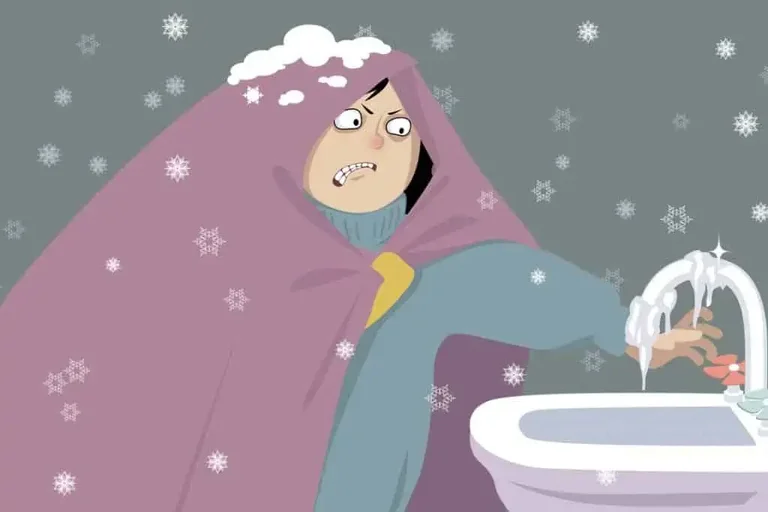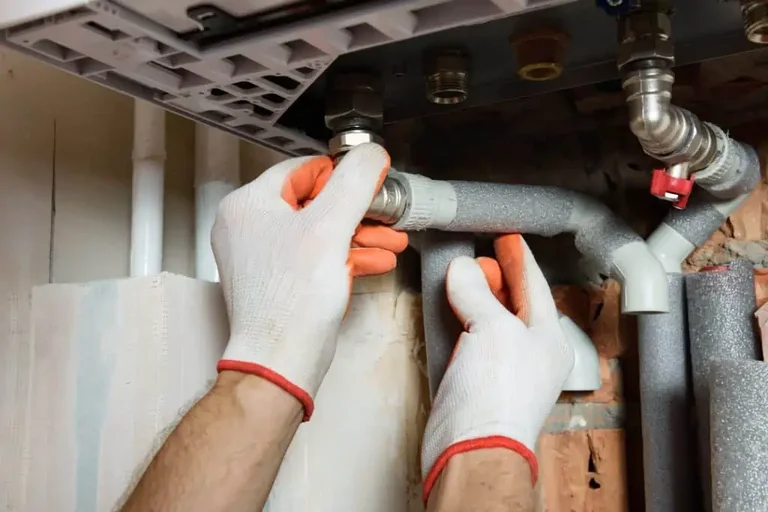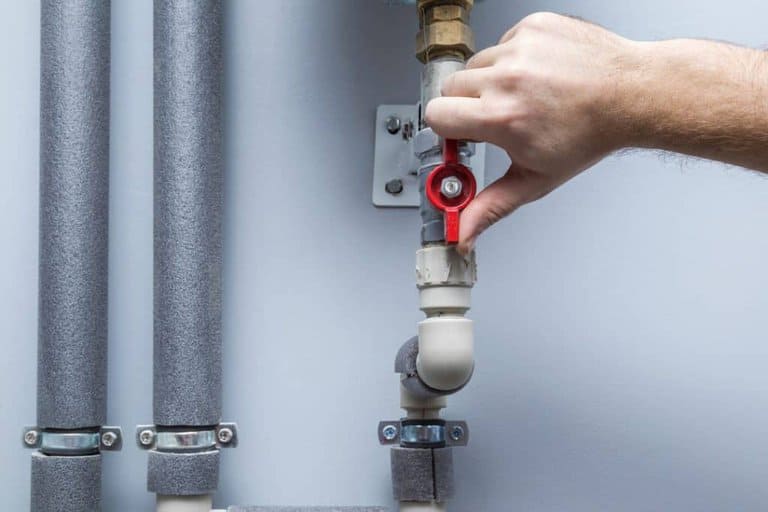The best practices to keep your house and pipes warm are: leaving a trickle of water running in the faucets, using portable heaters, allowing the circulation of warm air through the house, making sure your pipes have adequate insulation and using heating cables around the pipes.

What To Do When Your Furnace Goes Down
If your furnace is out, the first steps you can take to reduce damage to your pipes are:
- Shut off the valve that allows water to come into your residence
- Open all drain valves and faucets and let them run until the pipes are empty and without water running through them
- Flush all toilets and pour antifreeze substance in toilets and sinks to prevent the water in the traps from freezing (be careful with toxic substances because they contaminate your drinking water)
- Turn off the furnace emergency switch and drain the furnace boiler by opening its valve
- Open radiator vents and make sure that the boiler is filled with water again before you restart it
- Use electric water heaters to keep water warm for a few days after the outage
Being stuck with no heat can cause your pipes to freeze and burst, which is not a good scenario. There are things you can do to keep your pipes from freezing when your furnace is not working. The first thing you should do is call a reliable professional who can help you repair or replace your furnace.
Here are steps you can take if a situation arises.
Leave a Trickle Of Water Running In The Faucets
Keeping the water moving is always a good practice in case you are experiencing freezing temperatures because the pressure on your pipes will be lower.
Moving water is less likely to freeze. So slightly opening your faucets might buy you some time to deal with the problem better.
By having a low drip (it can be as low as you can get) the risk of freezing is reduced (and if it freezes, it reduces the chances of bursting).
Use Portable Heaters
Portable space heaters are a pretty good emergency solution to this problem. Try placing them throughout your home (especially where the pipes are most vulnerable to the cold). Make sure to keep watching them and don’t leave heaters unattended.
Allow The Circulation Of Warm Air
Improving the circulation of warm air in your residence will improve the situation as well. Opening spaces that contain plumbing like cabinets and closets will reduce the chance of freezing.
Make Sure Your Pipes Have Adequate Insulation

Pipes that are exposed to the external environment are more at risk. Insulating them will improve resistance to freezing and potential bursts. It’s not expensive and somewhat easy to do as well.
Making sure that your pipes are properly insulated is a good practice. You can do it by yourself or hire a contractor to take care of it.
Identify your water supply lines (it might be in the basement, crawl space, attic, exterior places, etc). Once you do that, cover the pipes with something to protect them: foam insulation pipe wrap, towels/blankets, or self-sealing foam insulation tubes.
Use Heating Cables
Another option is to use heating cables that apply steady heat to your pipes through electricity. It’s a great preventative measure to ensure your pipes are safe from freezing and bursting.
How to Prepare For (And Prevent) Frozen Pipe Emergencies
However, there are things you can do to prevent your pipes from freezing. If you don’t want to learn the hard way how to deal with this problem, here is a list of preventive measures you can take:
Turn Off The Main Supply (In Case You’ll Be Away From Home)

In the case you have a beach house or are going to take a trip away from home for some time, you can turn off the main water supply whenever you are not in town.
Your water shutoff valve can be located in different places, so make sure to know where it is and then turn it off. This also prevents leaks and pipe ruptures as well.
It’s also important that you release the water pressure to prevent frozen pipes from bursting. So after you shut off the water, you can: open a faucet, flush toilets, or even drain a hose for a few minutes to empty the remaining water standing in the pipes.
As a result, in the case that it freezes, it will have space to expand without bursting the pipes and causing you trouble.
Install a Smart Water Monitoring Device
You can also install a water monitoring device or leak detection alarm. These devices allow you to turn off the water from your phone! It also alerts you whenever there is unusual water use in your location (might be a red flag for potential leaking).
This will not stop pipes from bursting, but it can help reduce the damage caused in case it happens. Being notified of it quickly will save you time and money.
Keep Your House Warm
Allowing the circulation of warm air through your house is also a good practice. If you have a fireplace, you can also crank it up to keep your home heated.
You can also keep the temperature high during the night (no lower than 55° F, for example). This will result in a more expensive bill, of course, but it prevents freezing. It’s also important to notice that the cost of repair if the pipes freeze or burst will be much higher.
How To Deal With Frozen Pipes

Dealing with frozen pipes can be a bit of a headache. If you happen to notice that water is not flowing (or barely just dripping) from a specific faucet, you might have to deal with this problem. The most likely places are the ones that are more exposed to the cold.
One important thing to do is to make sure that the pipe has not already burst anywhere. Check for dripping sounds and visual signs of leaks in your entire house. If you find it has broken, turn off the water and call a plumber to help you deal with that.
Another tip is to keep the faucet open because water movement is better than standing water when thawing the pipes.
You can also try applying some heat to your pipes. Hairdryers and space heaters are good options. Even hot towels (soaked in water) can be helpful. Be careful and do not use anything with flames.
Another measure is to make sure to let the sunlight into your home, keeping the windows open and allowing the heat to come in.
While doing that, keep the faucet open. As the frozen area begins to melt, water will start flowing through and help the pipe melt the rest of the ice that’s left in the pipe.
Remember that you’ll have to call a professional to help you in case you are unable to locate the frozen area, or if the area is inaccessible.
Frequently asked Questions
Why Do Pipes Freeze?
Have you ever left a can of soda or beer in the freezer and forgot about it, only to find that it has burst? That’s exactly what happens with your pipes when they freeze.
When the water that is contained inside of your pipes goes from liquid to solid, it needs to expand and consequently takes out more space, putting bigger pressure on your homes’ pipes.
Your pipes are stronger than an aluminum can, so they will hold strong for a bit. But they too have a breaking limit, and with enough pressure, they will burst, crack and release water.
What Water Pipes Are At Risk Of freezing?
The more distant your pipes are from your homes’ heating, or the more exposed they are to the outside environment, the more likely they are to freeze.
So the first ones that need to be protected are outdoor lines (going to swimming pools or hoses) because they are more at risk. Inside pipes that are away from heat can also be in trouble.
What Is The Minimum Temperature To Keep Pipes From Freezing?
55° F is the minimum temperature to keep pipes from freezing. But to be safer, it should be between 60° F and 68° F. By doing that, you make sure that your pipes are warm enough not to freeze.
It’s tricky if you live in a warmer climate because your pipes are likely not properly insulated against the freezing cold. In this case, keeping the temperature above 68°F is a good practice.
How To Keep Pipes From Freezing Without Power
In the case the power in your house is out, what are the things you can do to prevent pipes from freezing?
- Running all of your faucets helps prevent freezing
- Getting a source of heat going is important (kerosene space heaters and fireplaces are good examples)
- Keeping your garage doors closed in case there are any water supply lines in there
- Wrap your pipes around hot towels or blankets
- Allow the circulation of warm air through your residence